Koláč (pronounced “co-latch”), a common and popular Czech pastry item, is made from a yeasted brioche dough, filled with a variety of fresh seasonal fruit and topped with crumbly streusel.
Kolache, kolatche, kolachky or koláče in Czech (plural, pronounced “co-la-tchay”) typically come in circular shapes (yes, they do look like pizza!). From the silver dollar-size ones traditionally served at weddings, to those the size of a dartboard.
When I was growing up in the Czech Republic, three other boys and I participated in a comical and slightly gross eating contest at a country fare.
Two adults held a giant koláč while we all bit as fast as we could toward the middle. The goal being to reach the five-Czech-crown coin baked inside. (I sadly didn’t win).
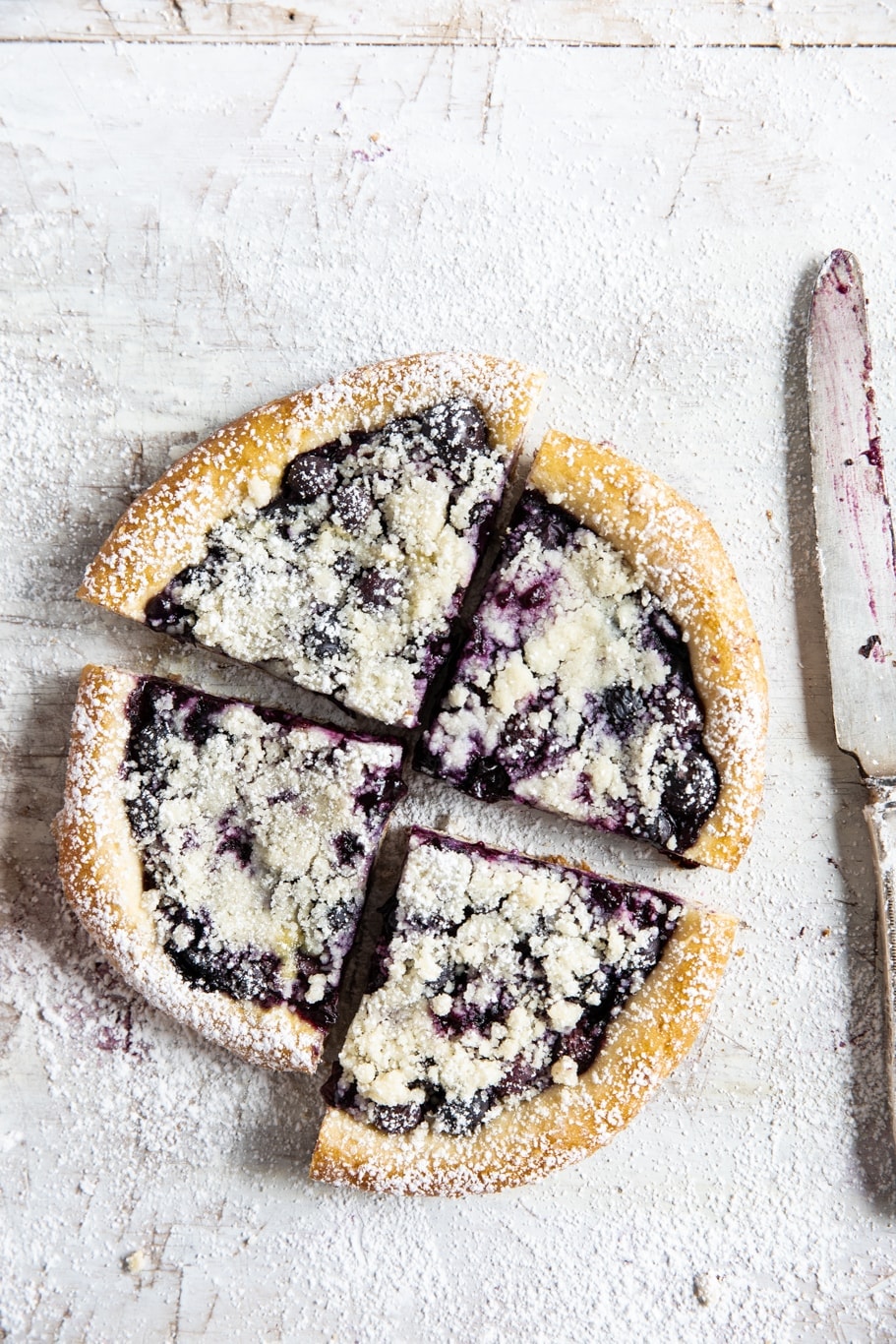
My mom’s fool-proof recipe here makes four, medium size koláče. They’ll be around 10 inches in diameter and yield about six to eight slices each.
The topping comes down to what’s on hand or currently in season. During summer in my family, we try to use up all the fruit as it becomes ripe in the garden: first rhubarb, then strawberries, followed by red currant, sour cherries, and apricots.
If wild blueberries from the local forest are sold by foragers on the side of the road, we jump at the opportunity and use those, too. In the fall, it’s about cooked apples and pears, plum jam, and poppy seed filling.
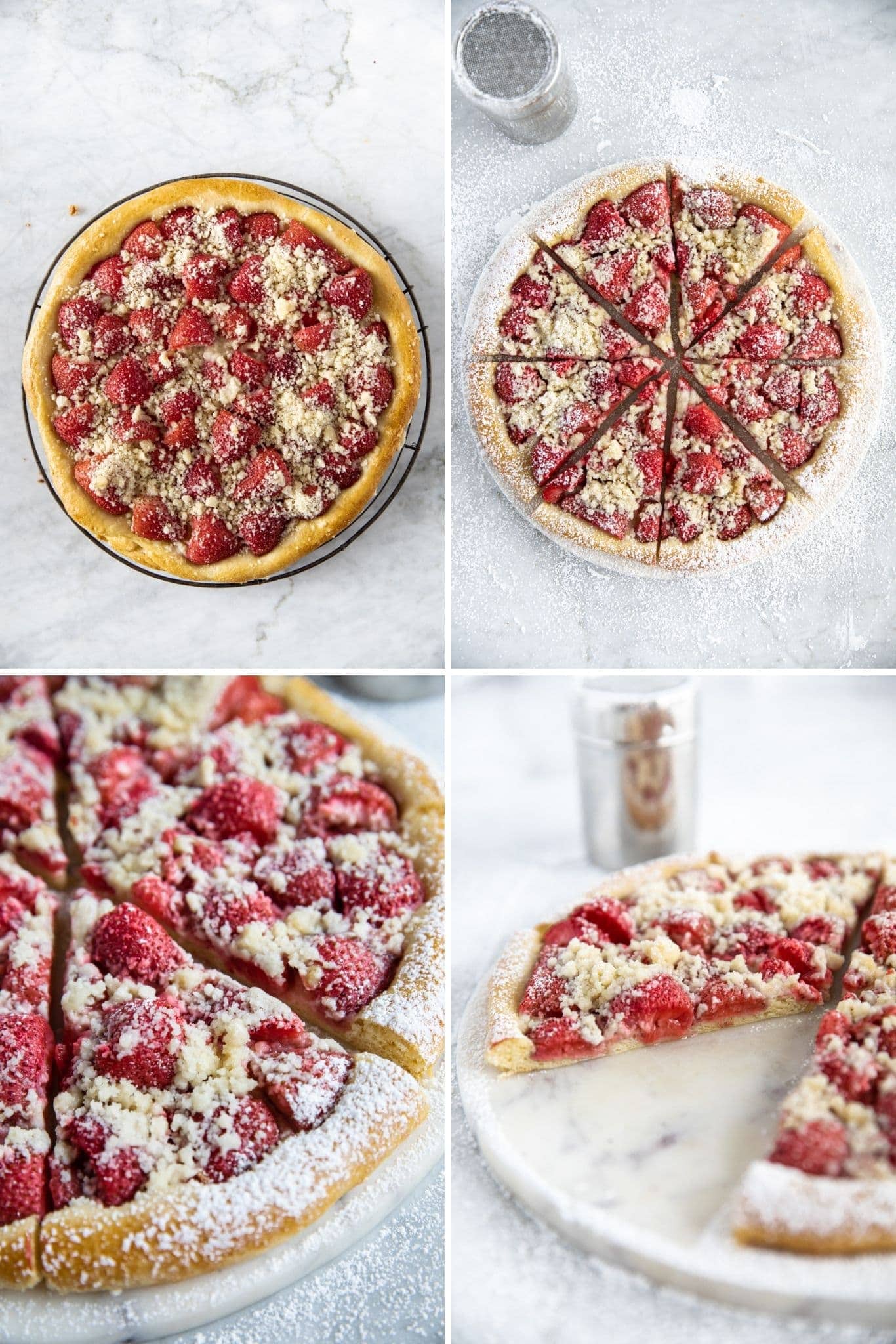
The kolache dough is buttery, elastic (like pizza’s) and easy to make. If you don’t have an electric stand mixer, roll up your sleeves, grab a wooden spoon, and use some elbow grease. That’s how my grandma used to do it.
9 Steps to Make Kolache Dough
Here is a visual guide to make the kolache dough by hand if you don’t own an electric stand mixer:
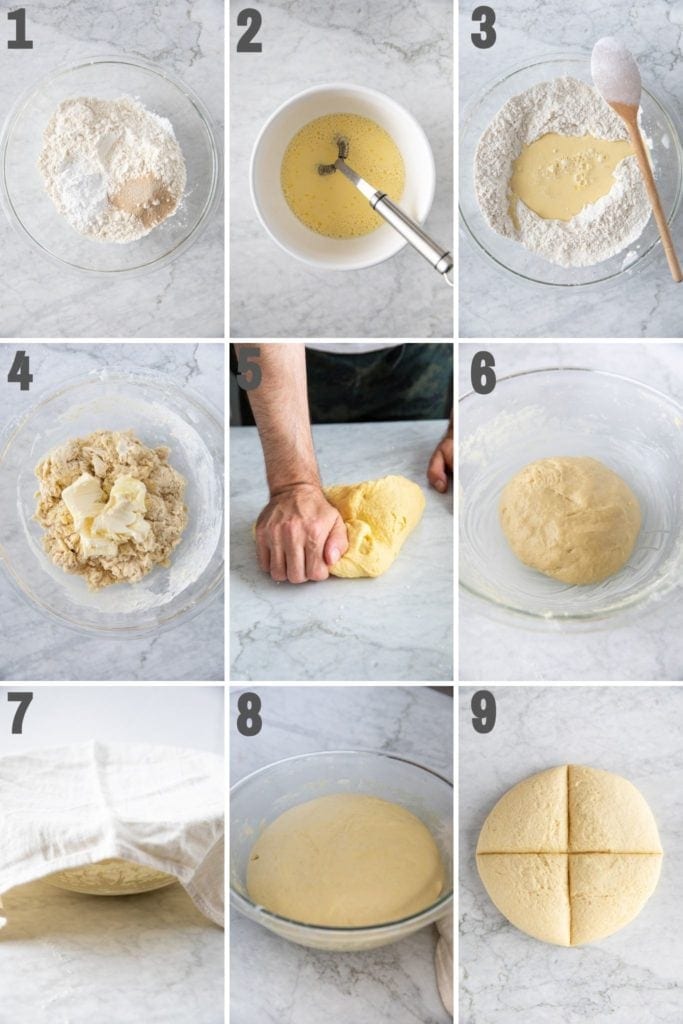
- Mix together the flour, salt, powdered sugar, and active dry yeast.
- Whisk 1 whole egg, 2 egg yolks, and lukewarm milk.
- Stir egg mixture into the flour mixture.
- Add softened butter.
- Knead butter by hand until glossy and elastic (about 8 –10 minutes).
- Place the dough in a greased bowl.
- Cover the bowl with a clean kitchen towel and let rise in a warm environment.
- Risen dough, doubled in size, after about 50 minutes.
- Divide dough into 4 parts to make individual kolache pastry.
How to Prep Kolache Dough for Filling
Grab a baking sheet, add parchment paper, and place one quarter of kolache dough in the middle.
Flatten the dough with your fingers and the back of your hand, into a circle about 10-inches in diameter, about 1/4-inch high, with a 3/4-inch rim. The rim acts as a border and prevents your filling from spilling out and making a mess.
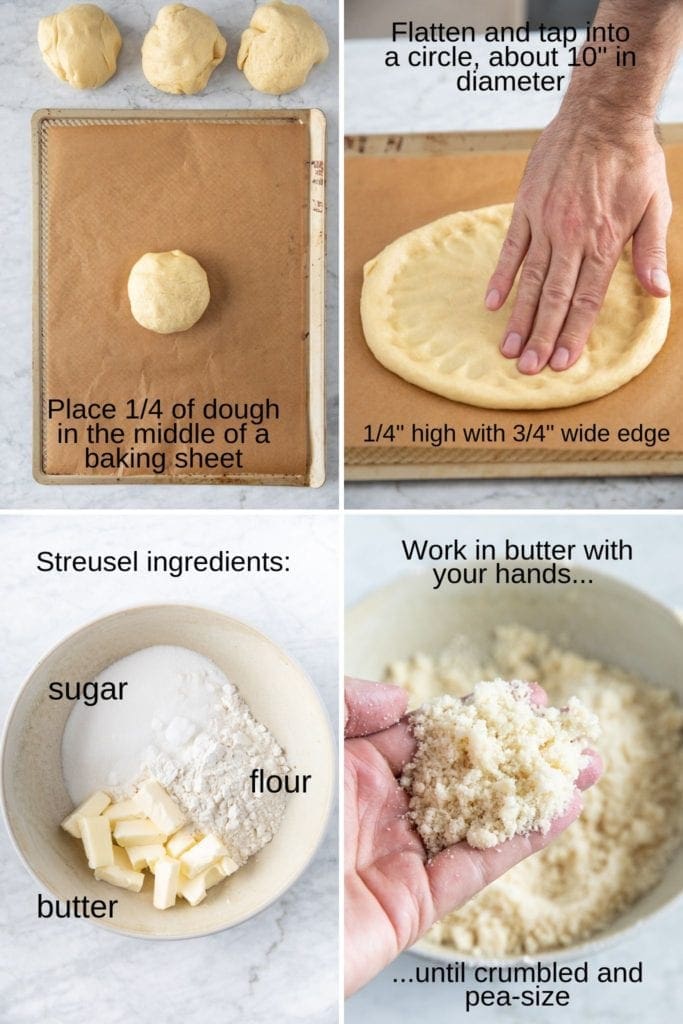
How to Make Streusel for Kolache
Streusel [SHTROY-zuhl] is a crumbly mixture of sugar, flour and butter that you’ll sprinkle on top of your filling. It adds an extra texture to your kolache and also a sweet, buttery flavor.
To make streusel, just work the butter with your fingers into sugar, and flour. Mix, toss, until crumbled and pea-size.
Authentic Filling and Topping Kolache Ingredients
Gather your filling and topping ingredients, and create your own version of this tasty Czech pastry.
In this recipe I’m using ripe apricots, blueberries and strawberries. They all grow in the Czech Republic and become available in summer. But scroll down for my Kolache FAQs to see what other filling you can use.
Use one type of fruit per kolach, or combine 2–3 types.
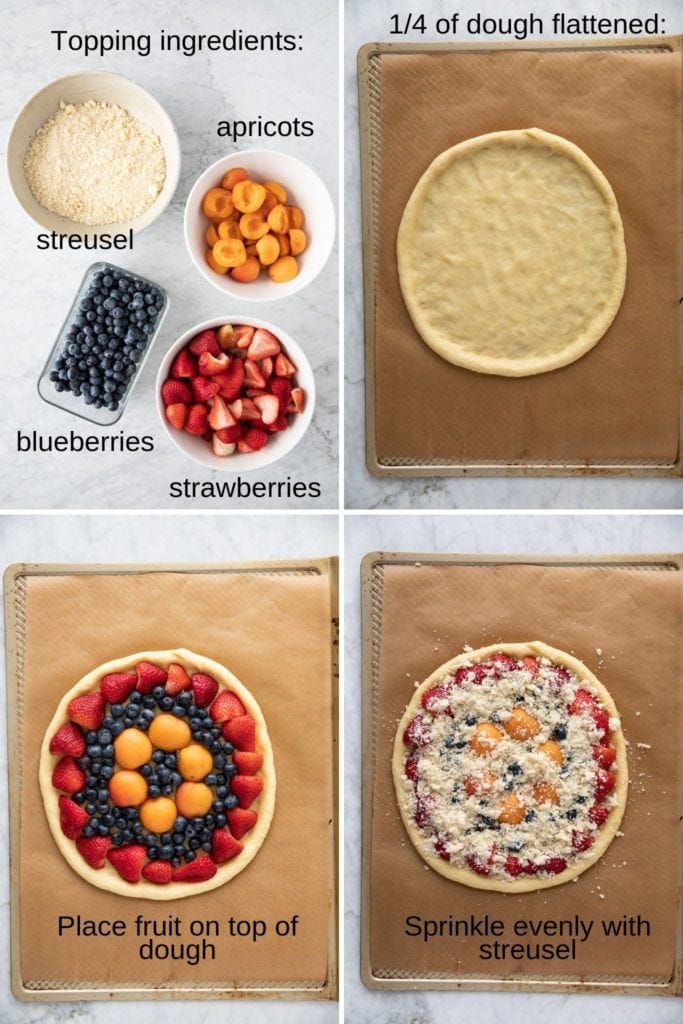
You can also make smaller kolache called koláčky in Czech (diminutive of the word koláče) by cutting the 1/4 of the dough in half
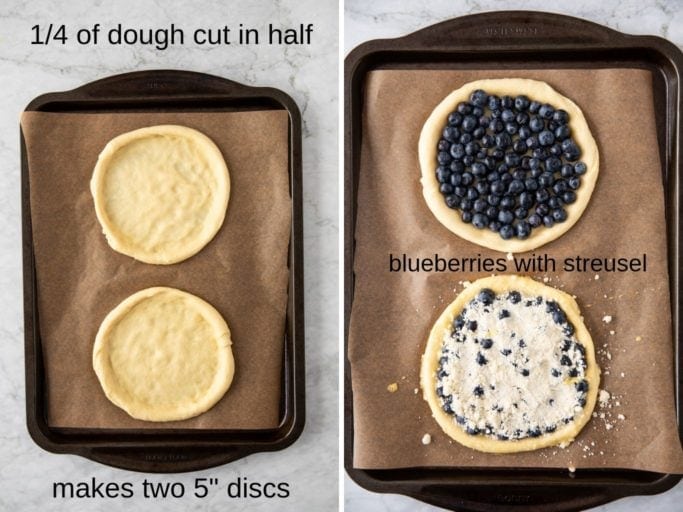
How to Serve Kolache
Kolache take about 20–25 minutes to bake at 350°F. Let them cool for about 45 minutes.
Sprinkle with powdered sugar, slice into wedges, and serve.
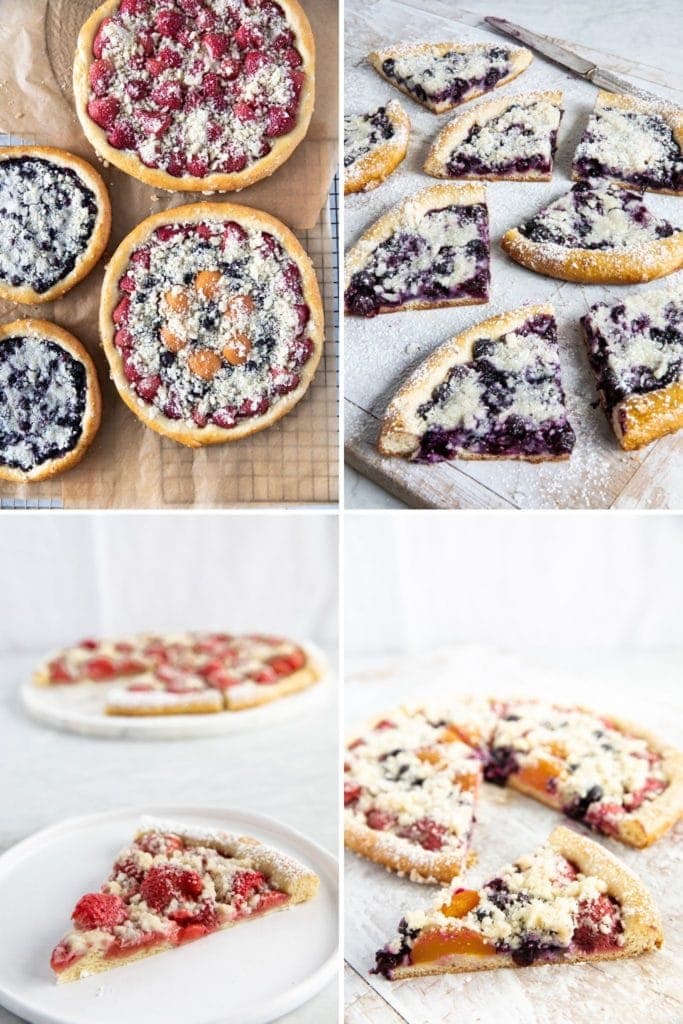
Czech Kolache Pastry FAQs
1. What kind of fruit can I use on kolache?
Seasonal, local, fresh, and ripe fruit is the best. Here’s what we use in my family: strawberries, apricots, blueberries, red and black currant, gooseberries, rhubarb, plums, cherries (pitted), sour cherries (pitted). Raspberries and blackberries work too, but if you hate the tiny seeds getting into your teeth, don’t use them.
Harder fruit, such as apples or pears need to be cooked first.
Peel and core 2 pounds of apples or pears, and cut into 1/2-inch thick slices. Place in a small pot, add 1 tablespoon water, 1 tablespoon cinnamon, 1 tablespoon freshly squeezed lemon juice, and cook covered over medium heat for 5 minutes, stirring occasionally. The fruit should will get a little softer, but stay compact. Let cool completely before using as a topping. You can do this a day ahead.
Strawberries and apricots might sometimes be too big, so cut them into smaller pieces. You want the fruit to cook through during baking, but also to fuse with the streusel.
2. Can I use frozen fruit or fruit from a jar?
You can use frozen fruit. Don’t rinse it though, because you’d loose the juice. Cut big pieces of fruit (strawberries, apricots) in half. Place it directly on the prepared, flattened dough. Evenly sprinkle with the struesel and lightly press down.
IMPORTANT: The frozen fruit will shock the dough, which will temporarily stop rising. Therefore, don’t put the kolach into the oven right away, because it would cause the crust to shrink and harden. Instead, let it rest on the counter for 15 minutes, and then bake.
Fruit from a jar works too, but make sure it’s not mushy. Apricots and cherries are typically great.
3. What about bananas, mangos, and exotic fruit?
Kolache are a Czech specialty so only locally grown fruit as mentioned above is mostly used. I think bananas and mangos would turn into a pool of mush. But feel free to experiment and let me know how it goes—who knows, maybe a pineapple kolach will be the next big thing.
4. What other kolache toppings are typically Czech?
- Ground poppy seeds cooked in milk, and flavored with honey, rum, butter and raisins
- Plum preserves called povidla.
- Czech soft fresh cheese called tvaroh (somewhere between ricotta and cream cheese) mixed with an egg, lemon zest, sugar and raisins.
- Cooked grated apples or pears, topped with grated gingerbread.
- All of the above combined in circular layers, which makes the kolache look like a pretty dart.
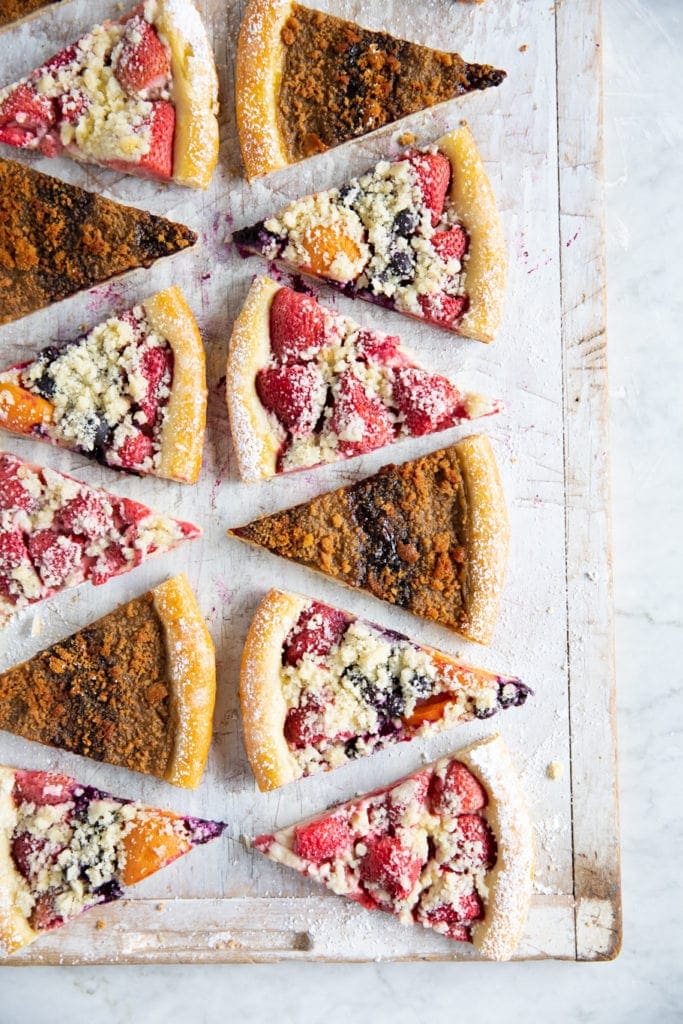
5. Can I use fresh yeast to make the kolache dough?
Yes! In fact, my mom always uses fresh yeast. It’s widely available in stores in the Czech Republic, and it’s also more reliable than dry yeast. Always check the expiration date on dry yeast.
If you have access to fresh yeast, use this helpful article to figure out the conversion for this recipe.
6. Can I freeze baked kolache?
Let them cool for an hour after baking, then slice. Stack four slices, layering each with a piece of parchment paper. Wrap tightly in aluminum foil and freeze for up to three months. (They won’t be as good after three months).
To thaw, spread the slices over a clean kitchen towel or paper towels, and let come to room temperature. The towels absorb any condensation.
Eat right away. Don’t freeze them again.
7. Can you reheat kolache?
In the oven or toaster oven for a few minutes. In the microwave for 20 seconds. You don’t want them to be super hot & steaming.
8. Do you eat kolache warm?
Everyone’s taste is different, but I wouldn’t eat them hot like pizza. They’re just perfect about 80 minutes after coming out of the oven, still a little warm and getting to room temperature. In my family, we like to eat kolache within 12 hours of baking—they won’t be as fresh after that.
9. Can I make the kolache dough ahead?
Make it, let it rise and double in size, then place the covered bowl in the fridge for up to 24 hours.
10. Can I freeze kolache dough?
Let it fully rise and double in size. Cut it into individual portions, then form it into buns. Lightly coat all over with vegetable oil and place in a plastic bag. Make sure it’s tightly wrapped with no air around it. Freeze for up to 3 months. Let thaw fully for 12 hours or overnight in the refrigerator.
11. What else can I make with the kolache dough?
This dough is amazingly versatile! My grandma used to roll the dough out to make it flat, brush it with melted butter, sprinkle with cinnamon, cocoa, sugar and chopped nuts, re-roll and stuff it into a bundt cake pan. It was completely free-form and rustic, but delicious.
You can also use it for buchty, another type of classic Czech pastry. Or for monkey bread.
12. When do you actually eat kolache?
They’re perfect for breakfast or with coffee in the afternoon. Or as a snack throughout the day. But they’re too filling to eat as a dessert after dinner.
Czechs eat sweet entrées for lunch btw, especially in the countryside. As a kid, my grandma would make this potato soup, which we would eat first, followed by kolache as the main thing. Unusual, but so good.
13. How do you store kolache?
Kolache will be good for about one day after baking them. Place them on a tray or a large cutting board, and loosely cover with a clean kitchen towel. Store in a cool place, but don’t refrigerate. Kitchen counter, larder or cellar work the best.
More Authentic Czech Recipes from Very Good Cook
My all time favorite potato soup: Czech Potato Soup (Bramboračka)
My grandma’s amazing pancakes: Fluffy Bohemian Pancakes
My mom’s incredible Christmas cookies: Linzer Cookies With Raspberry Jam
My favorite Czech childhood dish: Cream of Semolina With Two Toppings
My favorite breakfast thing: Cheesy Egg Nests
Now you.
Have you ever tried kolache? Do you make them regularly? Which topping is your favorite? Is there a Czech recipe you love?
Tell me in the comments.
Print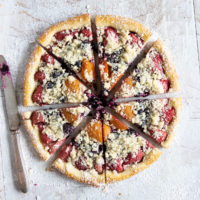
Authentic Czech Kolache (Koláče) with Fruit Filling and Streusel Topping
- Prep Time: 90 minutes
- Cook Time: 25 minutes
- Total Time: 1 hour 55 minutes
- Yield: 4 kolache or 32 slices 1x
- Cuisine: Czech
Description
Classic Czech pastry with fruit and streusel topping.
Ingredients
- For the dough:
- 2 whole eggs (1 egg for the dough; 1 egg for brushing the dough)
- 2 egg yolks
- 1 cup lukewarm whole milk
- 3½ cups unbleached all-purpose flour
- Pinch of salt
- ¼ cup powdered sugar
- 1 tablespoon active dry yeast
- 10 tablespoons (140g) softened unsalted butter
- 1 tablespoon vegetable oil, for greasing the bowl
- For the streusel topping:
- 1 cup unbleached all-purpose flour
- 1/3 cup sugar
- 7 tablespoons (100g) cold unsalted butter, cut into 1/2-inch cubes
- For the fruit topping:
- 20 fresh ripe, soft apricots, pitted, cut in half, or quarters if too big
- 4 cups fresh strawberries, destemmed, cut in half, or quarters if too big
- 4 cups fresh blueberries
Instructions
To make the dough in an electric stand mixer:
- In a small bowl lightly whisk 1 whole egg, both egg yolks and the lukewarm milk.
- Place the egg mixture, flour, salt, powdered sugar and yeast in the bowl of an electric stand mixer, and using the dough hook, mix for 1 minute.
- Add the butter, and mix until the dough is shiny and smooth, about 7 minutes.
- With your hands, form the dough into a smooth, round ball.
To make the dough by hand:
- In a large bowl mix together the flour, salt, powdered sugar, and yeast.
- In a small bowl lightly whisk 1 whole egg, 2 egg yolks, and lukewarm milk.
- Add the egg mixture to the flour mixture, and mix to combine with a wooden spoon. Add the butter. (It’s probably going to be too hard to stir and incorporate thoroughly with a wooden spoon, so feel free to dump the dough on a clean, lightly floured surface, and mix with your hands).
- Toss, turn and knead the dough with the palm of your hands for 7 minutes, until glossy and elastic.
- With your hands, form the dough into a smooth, round ball.
Once you have your dough:
- Grease the bottom and sides of a large bowl with the vegetable oil. Place the dough in the bowl and cover it with a clean kitchen towel.
- Let the dough rise undisturbed, in a warm place, until doubled in size, about 50 min – 1½ hours
While the dough is rising:
- Make the streusel topping: In a small bowl, combine the flour and sugar. Work in the butter with your fingers, lightly toss and mix, until crumbled and pea-size.
- In a bowl, lightly beat the 1 egg you reserved for brushing the dough.
To form kolache:
- Preheat the oven to 350°F (180°C), place two oven racks in the middle of the oven, and line four baking sheets with parchment paper.
- Dump the dough onto a lightly floured surface and divide into 4 equal parts.
- Shape each part into a bun and place it in the middle of a baking sheet. With your hands, gently flatten and tap the dough into a circle about 10 inches in diameter, ¼ inch high, and with a ¾-inch wide edge.
- Arrange the fruit evenly on top of the dough (strawberries and apricots cut-side down). Use either one type of fruit per koláč, or combine two or all three in a fun circular pattern.
- Brush the edge with the egg. Sprinkle 1/3 cup of the streusel evenly over the fruit, and lightly press down.
- Bake the koláče—two at a time—in the oven until the edge is golden brown, about 20–25 minutes. For even baking, switch the baking sheets halfway through, placing the top one on bottom and vice versa.
- Transfer to a cooling rack and let cool for about 45 minutes. Cut into slices and serve.
Notes
- See post for variations on fruit and other toppings.
- Freeze any leftover fruit for smoothies or other use.
- Kolache will be good for about one day after baking them. Place them on a tray or a large cutting board, and loosely cover with a clean kitchen towel. Store in a cool place, but don’t refrigerate. Kitchen counter, larder or cellar work the best.
- To freeze kolache: Let them cool for an hour after baking, then slice. Stack four slices, layering each with a piece of parchment paper. Wrap tightly in aluminum foil and freeze for up to three months. (They won’t be as good after three months).

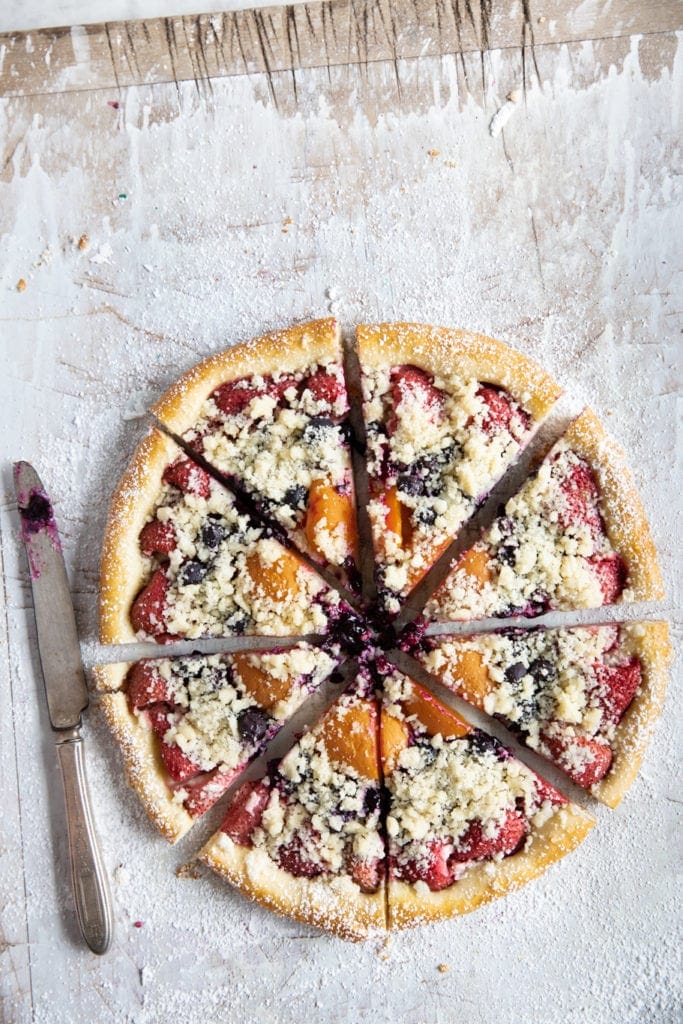
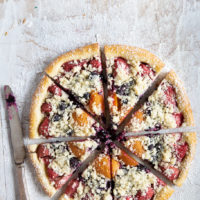
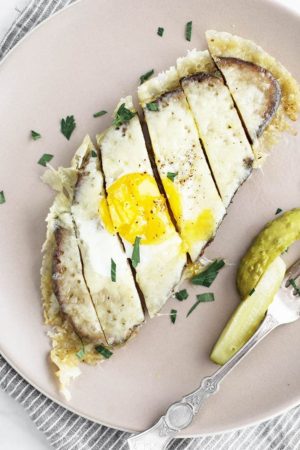
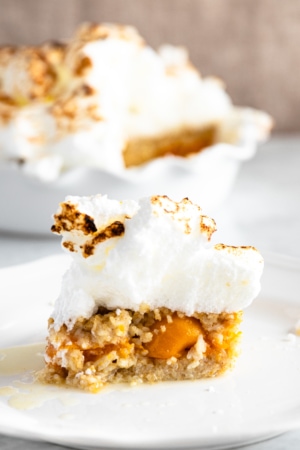
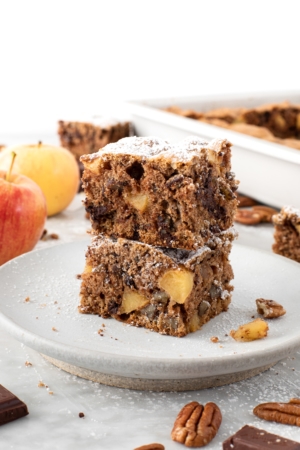
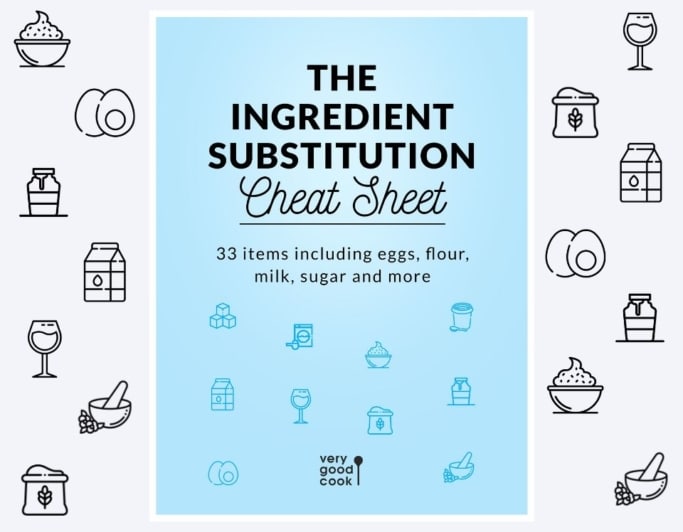
 buy me a flat white?
buy me a flat white?
Thank you very much! I have tried the recipe and I think I missed the dough though It was very soft and smooth before baking, but it turned out a bit cakey texture and kind of heavy not really soft, could be baking temperature ? Plus I did not have electric mixer so had to use my hands instead, how can I improve this ? I am so looking forward to do it better again
Thanks a lot for this and all the tasty recipes 👏🏼
★★★★★
Hi Zai,
So happy you tried kolache! I make mine by hand too – more labor intensive but def worth it. A little cakey (but springy and soft) is fine. It really depens on the thickness. The dough should be really flat and not too thick when you press it down and before you fill it.
If you want, shoot me an email to michal at verygoodcook dot com and send any pics. I will take a look.
Thanks!
Michal
Turned out great!! Finally able to do a kolac with American ingredients.
★★★★★
Thank you so much Lenka! Glad they worked out
Hi Michal, thank you for this recipe! I made kolache today and they turned out really well. My Czech partner said they tasted perfect. I accidentally put 2 whole eggs instead of just one whole egg, but it didn’t seem to make a difference – just added a bit more flour to compensate. The only thing I’d do differently next time is press the centre down much thinner because the dough rose quite a bit more than I was expecting. I used fresh strawberries and frozen blueberries for mine. I have tried to make kolache several times in the past but your recipe is the first recipe where the consistency of the pastry is most like the ones I had in Prague. Thanks again!
★★★★★
Thank you so much Julia! An extra egg in the dough is fine and yeah, the dough needs to be pressed thin because it rises high, and could become cake-like when baked – not a big problem since there’s a delicious version of kolach (Moravian) which is ball-shaped and filled inside – so just a preference.
I can’t wait to try this recipe. These are very popular in Texas. We always stop at The Czech Stop in West, TX!
Let me know how they turn out. I think these will be a bit different – at least based on what I had as “kolache” in the States
I am 100% Czech and have made and eaten! Kolaches my whole life. My grandmother came over when she was 16, but I have never seen a kolache like this. Ours are individual but I’m sure yours are delicious as well. They just look more like a tart.
Hi Jane, yes there are so many variations on kolache – different sizes, fillings and shapes. And the word in Czech doesn’t mean any specific recipe, more of a broad term for a pastry made from yeasted dough with some type of filling. Almost like the word cookie in English.
I tried this recipe, and it was really good, but I have questions I want to ask; how can I reach you?
★★★★★
I haven’t tried your recipe but it sounds very much like my husband’s grandmothers kolache. That said, she never made them any larger than a doughnut – individual pastries. I absolutely loved them. Her fillings typically were poppy seed, blueberry and apricot.
★★★★★
Thank you Lea – yes kolache can be made in different sizes – from tiny “wedding” ones to large “pizza-size”